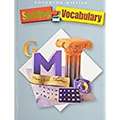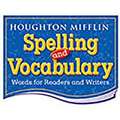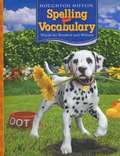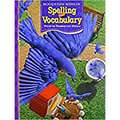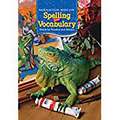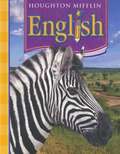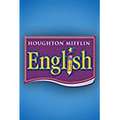- Table View
- List View
Houghton Mifflin Spelling and Vocabulary (Grade #5)
by Shane TempletonSpelling and Vocabulary English book.
Houghton Mifflin Spelling and Vocabulary (Grade #6)
by Shane TempletonA Grade 6 Spelling and Vocabulary English book.
Houghton Mifflin Spelling and Vocabulary (Grade #7)
by Shane Templeton Edmund H. HendersonThis is a Spelling and Vocabulary textbook.
Houghton Mifflin Spelling and Vocabulary (Grade #7)
by Shane TempletonThis book helps students improve their vocabulary and spelling by providing spelling strategies and showing how to study words.
Houghton Mifflin Spelling and Vocabulary (Grade #8)
by Shane Templeton Edmund H. HendersonAn English Spelling and Vocabulary book.
Houghton Mifflin Spelling and Vocabulary (Level #4)
by Shane Templeton Donald R. Bear Rosa Maria PeñaYour spelling book has six parts. At the beginning of each part, you will read an example of a different kind of writing, such as a personal narrative. Each part has six smaller parts, or units. In five of these units, you will learn spelling principles a
Houghton Mifflin Spelling and Vocabulary [Grade 7]
by Shane Templeton Donald R. Bear Rosa Maria PeñaNIMAC-sourced textbook
Houghton Mifflin Spelling and Vocabulary [Grade 8]
by Shane Templeton Donald R. Bear Rosa Maria PeñaNIMAC-sourced textbook
Houghton Mifflin Spelling and Vocabulary: Words for Readers and Writers
by Shane Templeton Donald R. Bear Brenda Sabey Sylvia Linan-Thompson Houghton Mifflin Company StaffHoughton Mifflin Spelling and Vocabulary: Words for Readers and Writers
Houghton Mifflin Spelling and Vocabulary: Words for Readers and Writers [Grade 3, Ball and Stick]
by Shane Templeton Donald R. Bear Brenda SabeyNIMAC-sourced textbook
Houghton Mifflin Spelling and Vocabulary: Words for Readers and Writers [Grade 3, Continuous]
by Shane Templeton Donald R. Bear Brenda SabeyNIMAC-sourced textbook
Houghton Mifflin Spelling and Vocabulary: Words for Readers and Writers [Grade 4]
by Shane Templeton Donald R. Bear Brenda SabeyNIMAC-sourced textbook
Houghton Mifflin Spelling and Vocabulary: Words for Readers and Writers [Grade 5]
by Shane Templeton Donald R. Bear Brenda SabeyNIMAC-sourced textbook
Houghton Mifflin Texas Math [Grade 4]
by Matt Larson Lee Stiff Kay Frantz Mary Alice Hatchett Miriam A. Leiva Jean M. Shaw Bruce VogeliNIMAC-sourced textbook
Houghton Mifflin Texas Math [Grade 5]
by Matt Larson Lee Stiff Kay Frantz Mary Alice Hatchett Miriam A. Leiva Jean M. Shaw Bruce VogeliNIMAC-sourced textbook
Houghton Mifflin The Nation's Choice: Level 1.1
by Houghton Mifflin HarcourtThe book is full of beautifully illustrated stories and is in a simple language. The book is for beginning readers. The biggest bonus in this book is cover-to-cover full-color presentation coupled with discussion questions at the end of each story unit.
Houghton Mifflin: English [Grade 2]
by Robert Rueda Tina Saldivar Lynne ShapiroNIMAC-sourced textbook
Houghton Mifflin: English [Grade 5]
by Robert Rueda Tina Saldivar Lynne ShapiroNIMAC-sourced textbook
Houghton Mifflin: English [Grade 5]
by Robert Rueda Tina Saldivar Lynne ShapiroNIMAC-sourced textbook
Houghton Mifflin: English [Grade 6]
by Robert Rueda Tina Saldivar Lynne ShapiroNIMAC-sourced textbook
Houghton Mifflin: Florida Reading (Level #4)
by J. David Cooper John J. PikulskiFlorida Reading has six themes of reading pleasure viz., Journeys, American Stories, That's Amazing!, Problem Solvers, Heroes and Nature: Friend and Foe and has a focus on Mysteries, Plays and Poetry.
Houghton Mifflin: Florida Reading [Level 2.1]
by J. David Cooper David J. Chard Linda H. ButlerNIMAC-sourced textbook
Houghton Mifflin: Florida Reading [Level 3.1]
by J. David Cooper David J. Chard Linda H. ButlerNIMAC-sourced textbook
Houghton Mifflin: Florida Reading [Level 3.2]
by J. David Cooper David J. Chard Linda H. ButlerNIMAC-sourced textbook




